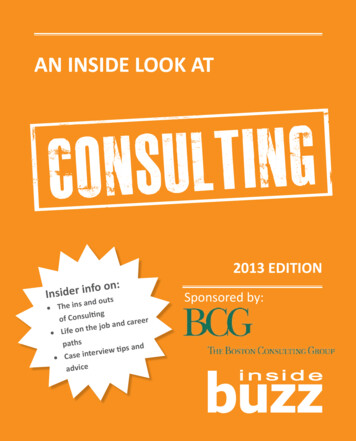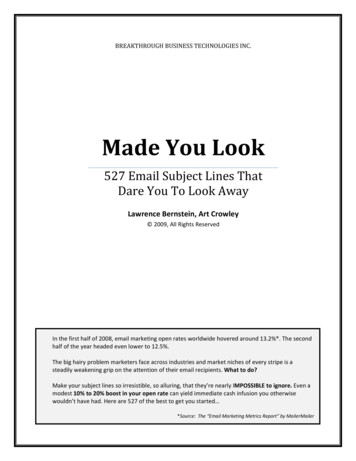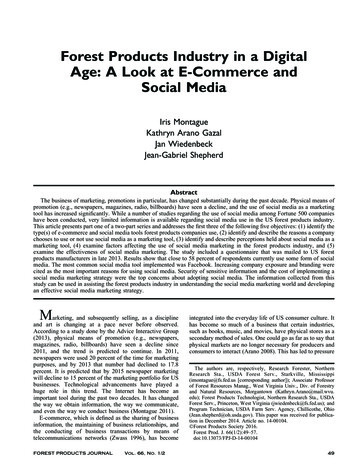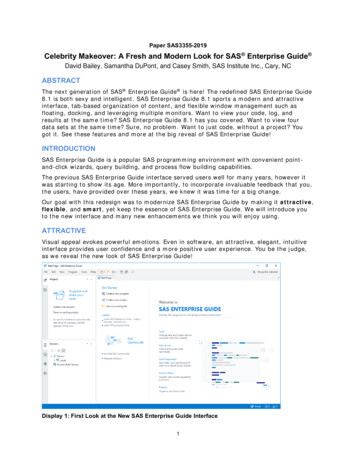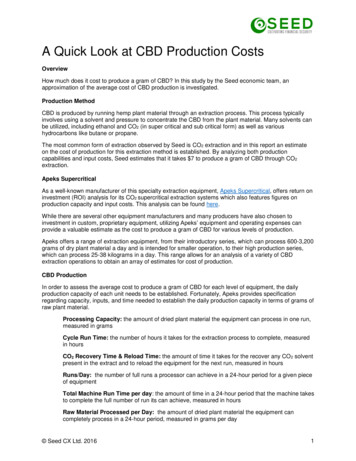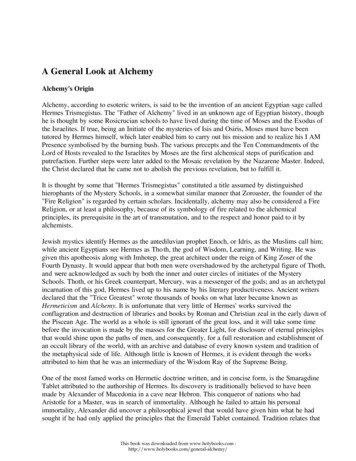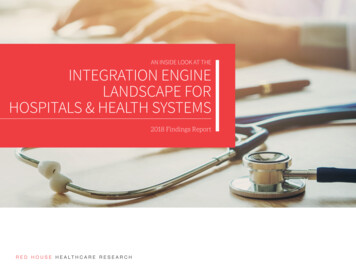
Transcription
AN INSIDE LOOK AT THEINTEGRATION ENGINELANDSCAPE FORHOSPITALS & HEALTH SYSTEMS2018 Findings Report
CONTENTS1METHODOLOGY4AIDED & UNAIDED AWARENESS8PERCEPTIONS16OPPORTUNITIES & CHALLENGES20INTEGRATION ENGINE OUTSOURCING24CONCLUSIONS
BRAND AWARENESS:METHODOLOGY AND MAKEUPwho responded andwhat we learned
BRAND AWARENESS: METHODOLOGY & MAKEUPwho responded and what we learnedMETHODOLOGYrespondent detailsThis survey consisted of nearly 75 onlineresponses from hospital and health systemIT leaders. In addition, several live phoneinterviews were conducted to add “color” to theTime on Job62%The majority ofrespondents have beenwith their companiesfor more than five years.overall response data and verify interpretations.Decision InfluenceThe survey took place over the course of threeweeks and represents a snapshot in time. Thefollowing results are what we believe to be73%insights into attitudes and understanding of theAlmost three-quartersinfluence or make finaldecisions aroundtechnology adoption.data integration engine market by IT buyers.Job FunctionUnlike many newer technology professionals,hospital and health system IT decision-makersare seasoned professionals. Seen in the “Timeon Job” graphic to the right, more than half ofthe respondents have been with their respective46%IT, Technology or InnovationOthers: Director Project Manager Program Coordinator Telehealthorganizations for more than five years.1
RESPONDENT DETAILSemployer makeup3%20%40%30%I am not involvedin these decisionsI makethese decisionsRole inTechnologyDecisionsCommunity HospitalHealth System24%I am a part ofthe discussion43%I influencethese decisionsType ofProvider forWhichYou Work74%Integrationwith ExistingEHR50%57%ImplementationCostsLength ofImplementationTime20%AcademicMedical Center34%11%23%Responsivenessof VendorsDevelopingCustom APIsOther9%11%OtherSpecialty PracticeTechnology ChallengesPurchase decisions are most often made as part ofa group rather than individually. Integrating withtheir current EHR is the most challenging part ofonboarding new technologies.2
BRAND AWARENESS:AIDED & UNAIDEDleaders and followersin the space
BRAND AWARNESS: AIDED & UNAIDEDleaders and followers in the spaceTop-of-Mind Integration PlatformsEpicHealthcareIBM TelusMulesoft All dox holds a slight edgein awareness over the toptwo We measure unaided awareness because it’s a good indicator of which brands are invited most often to RFPopportunities each year. Typically, the top three known brands (with some variation) are asked to participate.8%Redox awareness indicates a potential leadership position among provider organizations, but it is in closeIBMCerner23%Redox17%Epic13%Mulesoftproximity to the leading EMRs that typically supply integration tools within their own technology.4
BRAND AWARNESS: AIDED & UNAIDEDleaders and followers in the spaceTop-of-Mind Data Exchange VendorsInforIBM FHIRCloverleafMeditechMedicityCorePoint AWSOrionCernerMirthEpicAllscripts MicrosoftRedoxLatricHLOverall, awareness of digitaldata exchange vendors islow, but led by Cerner andRedox as well.MuleSoftIntersystems13%The narrow gap between vendors indicates that no one brand owns the space. However, as EMRs battle15%13%8%development on multiple fronts, the more problem-specific vendors have an opportunity to open a lead overthe EHRs if they can continue to add new levels of value and differentiating benefits that customers want.EpicRedoxCernerCloverleaf5
BRAND AWARNESS: AIDED & UNAIDEDleaders and followers in the spaceFamiliarity with BrandsCloverleafRedoxEnsembleCorepointCloverleaf has the highestRhapsodyusage in the market, withApigeeRedox coming in second.DaticaSansoroMuleSoftiNTERFACEWARE (Iguana)ELLKAYNot FamiliarSomewhat FamiliarVery FamiliarI Work with this BrandWe offered a list of competitive brands to the respondents, and asked about familiarity with each. As you cansee, while the top unaided brands lost some mind share, Cloverleaf loses the least. Rhapsody has the highestlevel of combined aided awareness, and is most likely one of the early players in the space. Interestingly,Redox (a relative newcomer), Ensemble and Rhapsody all have equal percentages in the Very Familiarcategory, meaning they’re all vying for the number-two position in the space.6
BRAND AWARENESS:PERCEPTIONScompetitive differentiatorsbetween brands
BRAND AWARNESS: PERCEPTIONScompetitive differentiators between brandsPerceptions of the ertConsultantQuick Timeto ValueAlthough Ensemble is seenas an experienced provider,Redox laps the field inresponsiveness, time to valueand easy implementation.Best inTheir IndustryResponsiveEnsemble appears to be the most experienced provider in the space, while Redox laps the field inResponsiveness and Time to Value. No one seems to be considered strong in the consulting area. AndCloverleaf leads in the area of Trust.What this shows us is that while most brands group similarly, Ensemble and Cloverleaf have figuredout how to use their experience as a differentiator. In the meantime, Redox has been busy owning theservice and timing areas, thus positioning them well against the key needs in the market.8
BRAND AWARNESS: PERCEPTIONScompetitive differentiators between brandsThe Importance of Speed as a Financial AdvantageMean Time to Integration (MTTI) If we shave two months off the integration, you just saved yourself400k. So, it’s my way of saying if I’m bringing something in, it must befinancially relevant or why would I do it? I’m not a complete idiot.Option 1:Internal ExecutionOption 2:MiddlewareOption 3:Redox120 Days100 Days30 Days“So, I’ve come to theconclusion that is aloser of an idea.”“A 10 percent, at best,decrease, maybe20 percent, best case.So, you go from about120 to 100 days.”“If Redox is betterafter doing three,imagine what it wouldbe after doing 23. Bigcompetitor advantage.”So, sooner would be better.– Pete, Redox customer9
BRAND AWARNESS: PERCEPTIONScompetitive differentiators between brandsSecurityAs a baseline, interviewees explain that vendors must be willing tosign security contracts and abide by all regulations.“ I think number-one right now is security. ADA and network security and regulatory compliance– specifically HIPAA – that is a very crucial part of what we do in this environment, and it canbe resource intensive. It requires a lot of dedication and perseverance to stay on top of all thoserequirements.”– Bart, Director of Information Technology and Information Management, state hospitalVery ImportantImportant Neutral/Not Important“ Well they would have to sign our BAA agreement. They would have to comply with HIPPArequirements. There is not really a certification that you have necessarily but they will have to haveother customers that sort of vouch for that and they have to agree to our security arrangements.”– Beth, CIO, pediatric hospitalSecurity10
BRAND AWARNESS: PERCEPTIONScompetitive differentiators between brandsScalableRespondents are looking for a solution that can adapt to a constantlychanging environment.“ We are always changing something, so as we change will it be able to be stable? Will it adapt and keepup with whatever the latest greatest whatever is? Does the vendor keep up to date? Do they lookVery Importantfor new versions of software and new versions of the interface that may then be able to integrateImportantwith something new and developed? So that is what I am referring to when I say compatibility, Neutral/Not Importantbut it definitely has to be scalable because we are always adding something or changing somethingwhenever new technology comes out.”– Angie, CIO, mid-size hospitalScalable11
BRAND AWARNESS: PERCEPTIONScompetitive differentiators between brandsMost ImportantWhile security is the mostimportant feature, support andcost are also important.SecurityVery Important24/7 SupportImportantCostNeutral/Not ImportantWhen asked about the most important features when selecting a vendor, we weren’t surprised to findsecurity at the top. In today’s environment, security of patient data is paramount when it’s being shared.We also see 24/7 Support as an important feature because tight budgets mean hospitals don’t haveenough full-time employees to manage everything that needs to get done, so more and more we seethem leaning on the vendor to pick up the slack.12
BRAND AWARNESS: PERCEPTIONScompetitive differentiators between brandsNice-to-HavesDashboards are somewhatimportant, as is quickimplementation, but otherfeatures are less so.Easy-to-UseDashboardsFully ManagedServiceVery ImportantQuickImplementationImportantCloud BasedNetwork ofPre-Connected Appsand TechnologiesNeutral/Not ImportantWhen considering other important features, Easy-to-Use Dashboards, Quick Implementation andNetwork of Pre-connected Apps are the top three additional benefits that would be considered nice tohave by buyers.13
BRAND AWARNESS: PERCEPTIONScompetitive differentiators between brandsDeal BreakersHealthcare experience andscalability are both ‘must haves’for selecting a partner as well asdeal breakers for those that arenot selected.Lack ofSupportPriceVery ImportantExperienceImportantLack ofScalabilityLengthyImplementationNeutral/Not ImportantWhen asked what would cost a vendor “the deal,” we were surprised at the almost unilateral need forsupport. Length of implementation (number three in overall importance) underscores the earlier findingsrelated to the need for quicker implementations.14
DIGITAL TRANSFORMATION:OPPORTUNITIES & CHALLENGESwhere hospitalsstruggle most
DIGITAL TRANSFORMATION: OPPORTUNITES & CHALLENGESwhere hospitals struggle most15%Not Sure27%The majority of respondentsNohave digital transformationAre You Planningfor DigitalTransformation?on their radar as a goal for theupcoming year.58%Yes“ We must have hundreds of things bolted into the EMR because we’re trying to take advantage of thecloud. We’re trying to hustle these days and make a horrid user experience much better.”– Pete, Innovation Officer16
DIGITAL TRANSFORMATION: OPPORTUNITES & CHALLENGESwhere hospitals struggle most10%I Don’t Know43%NoHaving a backlog of integrationDo YouMaintain aBacklog ofIntegrationProjects?projects is fairly common amongproviders, and all intervieweesspoke at length about theirchallenges in prioritizing and47%tackling their backlogs.YesWhen we look back to the mean time to integration findings, speed becomes more a greater point ofdifferentiation. With almost half of providers carrying a backlog of integration initiatives, the door iswide open for those that can cut time without cutting corners.17
DIGITAL TRANSFORMATION: OPPORTUNITES & CHALLENGESwhere hospitals struggle mostTime Behind on ProjectsBacklogs tend to be in the 1-6month range and can be causedboth by internal requests or avendors lacking the expertise tointegrate efficiently.1-3 Months4-6 Months7 Months-1 YearMore than 1 YearI Don’t Know“It seems like we always have a backlog of projects. More and more, everyone wants to connect to theEMR without having to send their data. I have four full-time developers who stay busy all of the timebut there are always new medical devices or hundreds of systems that want to send their data, or getdata, from our EMR so there is always a backlog.”– Beth, CIO, pediatric hospital18
INTEGRATION ENGINEOUTSOURCINGpriorities & potential
INTEGRATION ENGINE OUTSOURCINGpriorities & potential21%20%No, Not at AllNo, but We Planto Adopt OneMore than half of respondents13%say they have an integrationDo You Planto Partner withIntegrationVendor?Yes, WeUse a Servicesolution, but most others donot use an outside service.46%Yes, We Havea SolutionWhy hospitals & health systems outsource: Improve workflows, meet compliance needs, favorable ROI The need for interoperability is too great not to outsource Creating digital workflows for clinicians, linking disparate systems together Too many third-party applications not sharing data with the EHR20
INTEGRATION ENGINE OUTSOURCINGpriorities & potentialWhy Third-Party SolutionSpeedExpertise“ Sometimes the vendor’s time table or“ We don’t always have the resources or staffthe amount of resources that they canwith the right skill set to do something likedevote to the project don’t meet ourthat. They are hard to fill and recruit forexpectations. I think, in some cases, I’vethose types of positions, and they requirefelt like a third-party integrator serving as aa lot of programmer knowledge. And sincepivot point – or as a middle person – in thatright now we are using our own, thatprocess would help a lot. And I’m open tomakes it even more difficult because it isthat kind of arrangement on future projects.not a standard system that is used at otherIt’s been kind of a learning curve in that respectfor me. I’ve been in healthcare for about sixyears and previously I was in academia so itwas a real paradigm shift for me.”hospitals across the nation. That is one ofSpeed was one of the biggestreasons for outsourcing. Lack ofEHR experience was a commonreason against outsourcing.our largest challenges. And then even ifwe could recruit and find somebody, oftenretention is difficult. So having a vendorprovide that for us is a huge– Bart, Director of IT and Information Management,state hospitalcost-savings.”– Angie, CIO, mid-size hospital21
INTEGRATION ENGINE OUTSOURCINGpriorities & potentialValue of Integration PlatformRespondents believe that an integration platform connecting themwith applications would be valuable.“Ideally, it would be something that is completely turnkey and fully managed by the vendor that meetsall the security requirements.”– Angie, CIO, mid-size hospitalVery ValuableValuableThe general belief among IT decision-makers is that all technology suppliers say they can integrate with their Neutral/Not Valuablespecific EHR. But follow up interviews indicate the challenge that IT feels when having to connect hundredsof technologies, coupled with the reality of EHR updates that can break past integrations.A solution with “pre-connected” applications and reconnected provider sites would be a welcomesolution to the embattled hospital that faces months of back-logged integration projects that haveprofound impacts a hospital’s competitiveness—and in some cases, their ability to stay relevant and keepup with digital transformation.Value ofIntegration Platform22
BRAND AWARENESS:SURVEY FINDINGS REPORTvendor surveyconclusions
BRAND AWARENESS: SURVEY FINDINGS REPORTvendor survey conclusionsBRAND AWARENESSconclusionsThe data integration engine market has aYou may also be interested in seeing thewide range of players with no clear leader.application developers perspective on theWhile Epic and Cerner both offer integrationintegration engine space. You can learn moretoolkits, it’s clear that they have a long wayabout it by reading: “An Inside Look at theto go before becoming legitimate answersHealthcare Integration Engine Landscape forfor the immense need to integrate apps (andApplication Providers.” other technology data) into their platforms,and share it more seamlessly across thecontinuum. It is our expectation as competitorswork to define themselves, that Redox has anopportunity to continue to evolve and reshapebuyer expectations in a way that makes itdifficult for competitors to overtake them.24
ABOUT RED HOUSE HEALTHCARE RESEARCHRed House Healthcare Research, part of Red House HealthcareMarketing, is an industry-leading research group with decades ofexperience in healthcare.From awareness studies to messaging validation, we help clients gainthe insight necessary to create more predictable marketing success.Learn more at redhousehealthcare.com/capabilities/research Red House Healthcare Research. 2018. All Rights Reserved. Reproduction of this content, in part or in whole, is expressly forbidden without written permission from Red House.
Mar 13, 2018 · Cloverleaf All scripts Datica Meditech Intersystems Corepoint Apigee Mirth Infor Athena Healthcare IBM Telus Top-of-Mind Integration Platforms. 5 15% 13% 8% 13% Epic Redox Cerner Cloverleaf The narrow gap between vendors indicates that no one brand owns the space. However, as EMRs b


